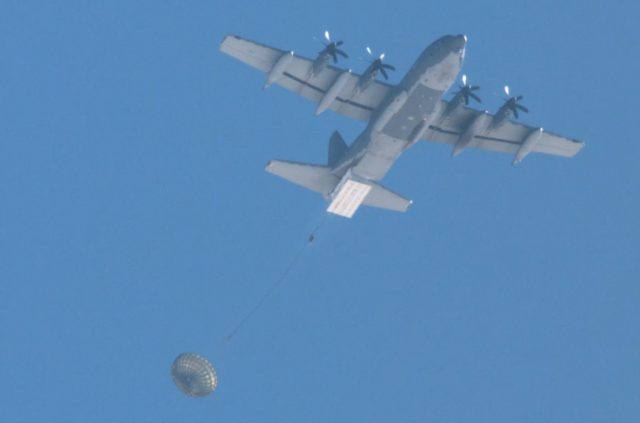
The US Air Force’s effort to have transport planes deploy standoff weapons the same way they drop palletized cargo is now named Rapid Dragon, the service revealed in a release touting progress on the project.
Previously known as the Palletized Munitions Program, Rapid Dragon aims to enable various airlift aircraft to employ a range of weapons en masse via a self-contained, roll-on/roll-off palletized system.
Dr. Dean Evans, Rapid Dragon Program Manager with the Air Force Strategic Development Planning and Experimentation (SDPE) office, said the office demonstrated that the program was able to overcome issues identified in previous tests related to the stability of airdropped palletized munitions.
This success will improve the likelihood of rapid fielding and “significantly reducing the risk of costly failures during a planned live-fire demonstration later this year.”
“Now, more than ever we must take a different approach to how we deliver capability to the warfighter,” said Chris Ristich, Director of SDPE. “Lengthy formal acquisition programs won’t deliver the future force we need, and Rapid Dragon demonstrated that through collaboration and well thought-out programs, we can rapidly field relevant capabilities to meet the demands of today and tomorrow.”
Evans stated the program began as a concept in September 2019, and SDPE began work on it in December 2019 as a pathfinder program, pairing SDPE with operators, acquisition professionals, and requirement owners to explore the operational advantages of utilizing existing airlift platforms to airdrop long range munitions without aircraft modifications.
The US Air Force has already tried launching joint air-to-surface standoff missiles (JASSM) from a C-17 transport aircraft, and simulated Cargo Launch Expendable Air Vehicles with Extended Range (CLEAVERs) from an MC-130J special operations tanker in two separate tests last year.
The Emerald Warrior demonstration from February and March this year was the latest advancement for the program’s accelerated timeline, which already met proof of concept, validation of future force impacts, demonstrated weapons communications and reduced prototyping risks.
“Being able to leverage operational exercises such as Emerald Warrior is essential to successful programs as they help us buy down risk and save time and money by ensuring we can quickly pivot to incorporate operator feedback into our programs before changes become more costly,” Evans said.
He explained that previous iterations identified stability concerns which would have hindered the ability to reliably deploy palletized munitions in operational situations.
Emerald Warrior events evaluated parachute and rigging configurations to verify that the stability issues could be corrected to employ Joint Air-to-Surface Standoff Missiles (JASSM) en masse at operational altitudes, adding that actual stabilization rates observed during the tests outperformed modeling predictions – potentially improving the capability by reducing the range loss and increasing weapon de-confliction.
This event also demonstrated, for the first time, the successful use of G-11 parachutes for airdrops at high altitude; setting an altitude record for their deployment from an air transport aircraft.
During the exercise, key partners from HQ AFSOC, and aircrews from AFSOC units, Lockheed Martin Missiles and Fire Control Advanced Program test engineers, and a rigging team from Safran Electronics and Defense, Parachute USA Corp. worked alongside SDPE in support of the demonstration.
“The Rapid Dragon program offers just one example of how SDPE is accelerating change to deliver operationally relevant capabilities for the Future Force,” said Rudy Klosterman, SDPE’s Experimentation and Prototyping Division Chief. “These experimentation and prototyping efforts coupled with our development planning, and modeling, simulation and analysis capabilities deliver the credible evidence needed to assess operational utility, highlight risk reduction and mission trades, and inform tactical and strategic acquisitions.”


























